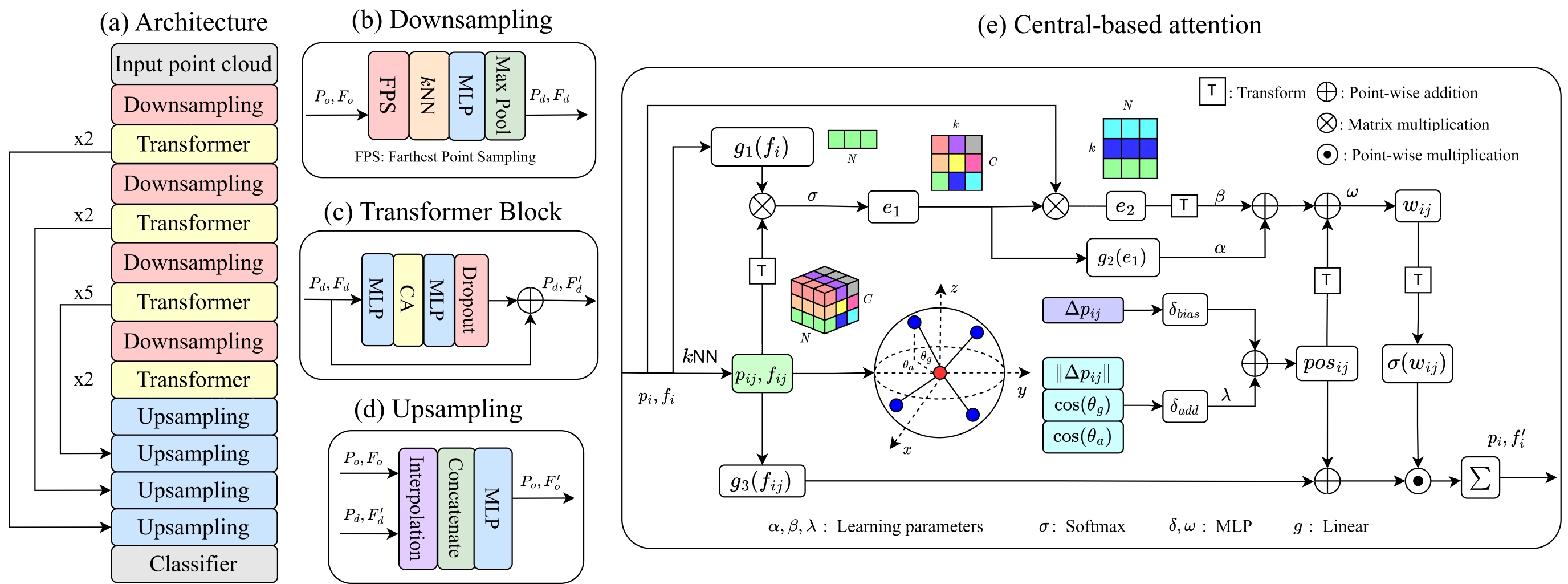Anh-Thuan Tran, Hoanh-Su Le, Suk-Hwan Lee, Ki-Ryong Kwon
This is the official PyTorch implementation of our paper PointCT: Point Central Transformer Network for Weakly-supervised that has been accepted to WACV 2024. [CVF]
- We propose a novel end-to-end trainable transformer network with central-based attention to overcome sparse annotations in point cloud segmentation.
- We introduce position encoding module in point cloud weak supervision, concentrating on different geometric components to extract point representations and improve model spatial reasoning.
- Our experimental results on benchmark datasets demonstrate the outstanding performance of PointCT compared to state-of-the-art studies for both indoor and real-world point clouds.
- Ubuntu: 20.04
- Python: 3.7
- PyTorch: 1.10.1
- CUDA: 11.3
- Hardware: 2 GPUs (NVIDIA RTX 3060) to reproduce PointCT
- Install dependencies
pip install torch==1.10.1+cu113 torchvision==0.11.2+cu113 torchaudio==0.10.1 -f https://download.pytorch.org/whl/cu113/torch_stable.html
pip install -r requirements.txt
- Compile pointops
Make sure you have installed gcc and cuda, and nvcc can work (Note that if you install cuda by conda, it won't provide nvcc and you should install cuda manually.). Then, compile and install pointops as follows.
cd lib/pointops
python3 setup.py install
Please refer to https://github.com/yanx27/Pointnet_Pointnet2_pytorch for S3DIS preprocessing. Then modify the data_root entry in the .yaml configuration file.
Please refer to https://github.com/dvlab-research/PointGroup for the ScanNetv2 preprocessing. Then change the data_root entry in the .yaml configuration file accordingly.
Please refer to https://github.com/meidachen/STPLS3D/tree/main/point-transformer for STPLS3D preprocessing. Then modify the data_root entry in the .yaml configuration file.
For testing, first check the save_path, resume and labeled_point (if applicable) accordingly. Then, run the following command.
[CONFIG] = config/s3dis.yaml, config/scannet.yaml, config/stpls3d.yaml
python3 train.py --config [CONFIG]
Note: It is normal to see the the results on S3DIS fluctuate between -0.5% and +0.5% mIoU maybe because the size of S3DIS is relatively small, while the results on ScanNetv2 and STPLS3D are relatively stable.
For testing, first change the model_path, save_folder and data_root_val (if applicable) accordingly. Then, run the following command.
For S3DIS, STPLS3D test set and ScannetV2 validation set, we use following command.
[CONFIG] = config/s3dis.yaml, config/scannet.yaml, config/stpls3d.yaml
python3 test.py --config [CONFIG]
For benchmark ScannetV2 test set, we use following command.
python3 test_scannet.py --config config/scannet.yaml
If you find this project useful, please consider citing:
@inproceedings{tran2024pointct,
title = {{PointCT}: Point Central Transformer Network for Weakly-Supervised Point Cloud Semantic Segmentation},
author = {Anh{-}Thuan Tran and
Hoanh{-}Su Le and
Suk{-}Hwan Lee and
Ki{-}Ryong Kwon},
booktitle = {Proceedings of the {IEEE/CVF} Winter Conference on Applications of Computer Vision},
pages = {3556--3565},
year = {2024},
}
We refer Point Transformer and Stratified Transformer for our codebase.
